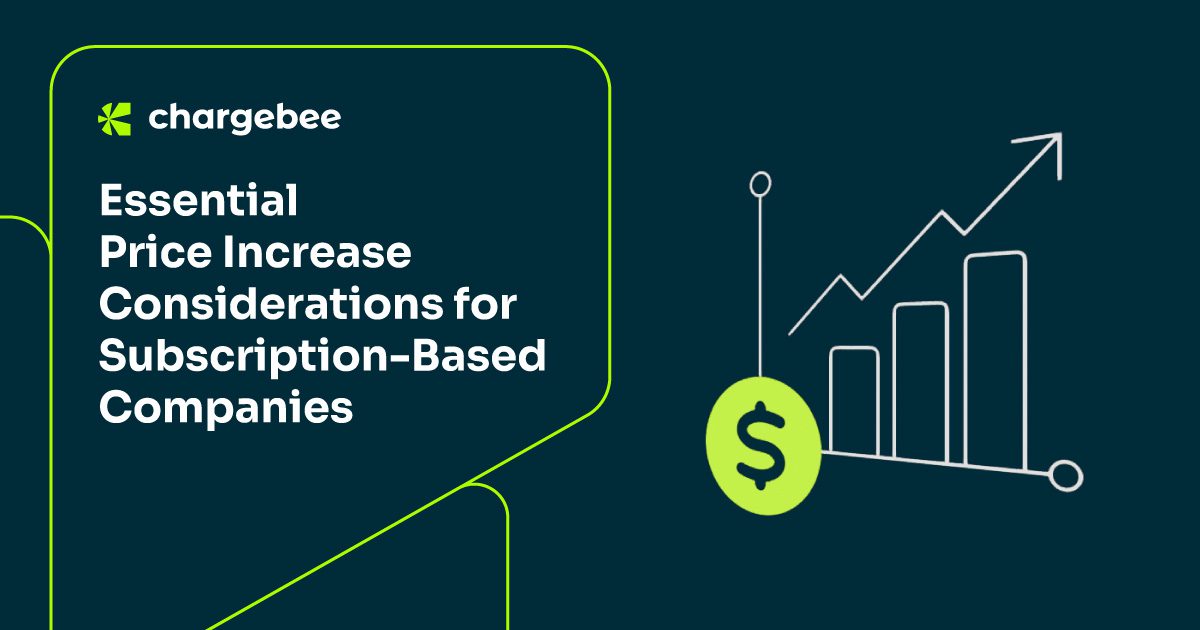Subscription-based services are rapidly evolving, with an increasing number of companies considering price adjustments. According to recent 2024 State of Subscriptions and Revenue Growth data, nearly three-quarters (73%) of subscription leaders are planning to raise prices this year, marking an increase from 62% in 2023.
However, with the prospect of increased revenue, subscription companies must carefully evaluate pricing strategies and anticipate their impact on customer acquisition and churn rates. It’s vital to acknowledge that price increases can significantly impact customer satisfaction and loyalty.
Table of Contents
Maximizing value propositions and revenue growth
One effective approach to navigating price increases involves evolving the value proposition of your subscription service. By exploring innovative pricing plans, packaging options, and discounting strategies, you can unlock new monetization opportunities while mitigating the risk of churn. This proactive approach drives revenue growth while fostering a deeper understanding of customer needs and preferences.
Adam Lifshitz, Senior Product Director of Subscriptions at Condé Nast, paints the picture of an era where marketing was rooted in “deals and steals” – a model focused on premiums and price-based offers, which may have opened the door to new subscribers, but it wasn’t always retaining them as well as others.
Lifshitz says, “We’ve evolved our messaging to emphasize the value of our subscription beyond just the included premium gift, understanding that it’s not the sole factor in closing a sale. We aim to ensure subscribers see it as a bonus, not the main reason for their subscription.“
Understanding the impact on churn rates
It’s essential to acknowledge that price increases may lead to higher churn rates if they affect existing customers. While the decision to raise prices may be justified by various factors, it’s crucial to implement changes thoughtfully and strategically.
The bottom line: EBITDA margins and profitability
Research indicates that well-implemented pricing changes can significantly impact EBITDA margins and profitability. For instance, a 5% price increase can result in a substantial 20% boost in EBITDA. Therefore, it’s essential to justify price adjustments through added value and improved customer experiences.
Critical considerations for successful price increases
Before raising prices, it’s crucial to have a solid rationale and strategy beyond timing or cost variations. Justifying the price increase is paramount. Indications that you’re prepared may include:
- You’ve added value. Your obsession with product development has meant more quantifiable value for your customers, higher ROI, new modules, features, etc, that you haven’t monetized.
- Your customers are showing less resistance to negotiating lower prices.
- Your competitors are increasing their prices.
- Market message and impact
When contemplating price increases, there are several factors to consider:
- Value addition: As mentioned above, ensure that any price increase is justified by tangible value additions to your product or service, such as enhanced features, modules, or ROI.
- Competitive landscape: Evaluate how your pricing strategy aligns with competitors and how your product differentiation impacts perceived value.
- Segmentation strategy: Segment your customer base to understand pricing sensitivity across different demographics and tailor pricing changes accordingly. Geographic location is a good consideration.
- Behavioral analysis: Analyze customer behavior patterns to identify segments that may be more receptive to price increases and implement changes strategically.
- Feedback and iteration: Remain open to customer feedback and be prepared to iterate on pricing strategies based on market responses and customer needs.
- Current customers: Don’t forget about them! Ideally, a well-founded price increase should also affect your NRR rates and help you increase rates at renewals with current customers.
The importance of testing pricing changes
Testing is crucial, and while complex methods often require tools, there are also simpler ways to gather initial feedback. The testing approach can vary significantly based on factors like pricing changes or the company’s profile (B2B versus B2C). For instance, in a sales-driven B2B setup, experimenting with different prices within a sales cycle or offering your sales teams options like price A and price B can increase win rates and profits.
Before diving into testing as the initial phase, we recommend considering the following key points:
- Ensure you establish a concise hypothesis to validate. Understanding the test’s focus is key. It’s common to observe cases where customers test new value metrics and price levels simultaneously, leading to confusing and ineffective outcomes.
- Establish clear Key Performance Indicators (KPIs) to define success prior to testing. We all possess biases, and without concrete result expectations, we may be inclined to persist in an initiative, whether or not data supports it as the optimal course of action.
Conclusion
While price increases can be a powerful tool for driving revenue growth, they must be backed by a well-thought-out strategy to minimize the risk of churn and maximize customer satisfaction. By adopting a customer-centric approach and carefully evaluating the impact on profitability, you can successfully navigate price increases.
Ready to harness the power of subscription and revenue growth management?
Get a demo of Chargebee and experience subscription growth in the fast lane.

